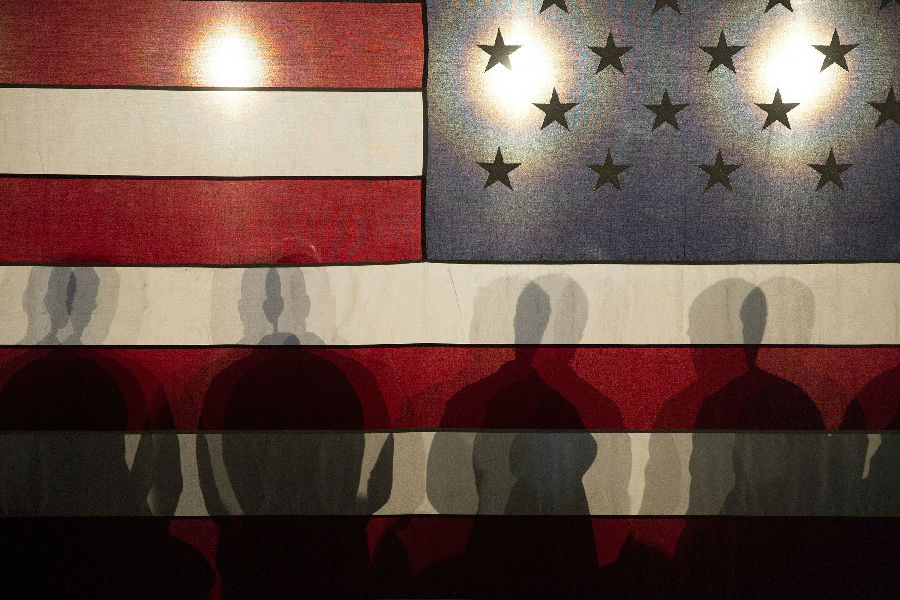But in this community, the election of Donald Trump also factors—and not only as a target of student protests.
但在華盛頓區(qū),特朗普的當選也起了一定的作用——不僅僅是作為學生抗議的目標。
The President, who exit polls showed carried only 8% of the African-American vote in 2016,
這位總統(tǒng)——投票后的民調顯示,2016年時他在非裔選民中間的支持率僅為8%——
famously hosted a Oval Office photo op with the leaders of HBCUs,
在他的辦公室舉辦了一場著名的與HBCUs領導人合影的合影活動,
which rely on federal funding for a significant portion of their budgets.
而這次活動的預算很大程度上依靠的都是聯(lián)邦資金。
And with both houses of Congress being controlled by Republicans,
由于國會兩院都在共和黨的控制之下,
administrators and supporters have been obliged to balance the energy of resurgent student activism
這些院校的管理層和支持者便有義務平衡復興的學生運動的活力
with the continuing practical needs of an educational institution.
和教育機構持續(xù)的現(xiàn)實需求。
"It is a dual-edged sword," says Crystal de Gregory,
“這是一把雙刃劍,”肯塔基州立大學
director of Kentucky State University's Atwood Institute for Race, Education and the Democratic Ideal.
阿特伍德種族、教育和民主理想研究所所長克里斯特爾·德·格雷戈里說道。
STARTED AFTER THE Civil War in the basements of churches, old schoolhouses and cabins,
這些傳統(tǒng)黑人院校始建于內戰(zhàn)結束后,一開始是在教堂的地下室,舊校舍或者小木屋辦學,
HBCUs were the first institutions dedicated to the education of former slaves and free black people.
但它們是最早致力于教育前奴隸和自由黑人的機構。
From their modest beginnings, they have produced alumni who transformed America, from W.E.B. Du Bois to Thur good Marshall.
最初默默無聞的他們逐漸培養(yǎng)出了W.E.B.杜波依斯,圖爾·古德·馬歇爾那樣一代又一代改變了美國命運的校友。
In the early 1960s, HBCU students played a pivotal role in the civil rights movement.
上世紀60年代初,HBCU的學生們還在當時的民權運動中發(fā)揮了中流砥柱的作用。
The Student Nonviolent Coordinating Committee, which fought segregation,
反抗種族隔離的學生非暴力協(xié)調委員會,

was formed after a conference of 300 students at North Carolina's Shaw University.
就是在北卡羅萊納州肖大學的300名學生舉行了一次大會后成立的。
Four students at North Carolina A&T State University in Greensboro launched the sit-in movement at a nearby lunch counter.
格林斯博羅的北卡羅來納農工州立大學的四名學生在附近的一個便餐館發(fā)起了靜坐運動。
Congressman John Lewis, then a student at Fisk University in Tennessee,
現(xiàn)任國會議員約翰·劉易斯當時還是田納西州菲斯克大學的一名學生,
was one of the original 1961 Freedom Riders, who galvanized civil rights protests across the nation.
就已經加入了1961年最早的一批“自由乘車者”組織,該組織后來發(fā)起了一場全國性的民權抗議運動。
But as major universities desegregated, competition for students grew, leading to declining enrollment at HBCUs.
然而,隨著各大高校陸續(xù)取消了種族隔離制度,高校之間對學生的競爭便愈來愈激烈,以致于HBCUs院校的招生人數(shù)不斷下降。
This posed a challenge for the schools, which rely disproportionately on tuition for their operations.
由于這些學校的運作嚴重依賴于學生的學費,招生人數(shù)的下降便給它們帶來了一個不小的難題。
Small endowments, drops in philanthropy and low investment also exacerbated financial woes.
收到的捐贈金額有限、慈善事業(yè)的下滑和投資的減少也加劇了這些院校的經濟危機。
Because HBCUs are reliant on federal funding, small changes in Washington can hurt on campus.
由于HBCUs還依賴著聯(lián)邦的資助,華盛頓稍有風吹草動,這些學校就可能要承受巨大的損失。
In 2011, the Obama Administration altered the credit underwriting requirements for Parent PLUS college loans,
比如,2011年,奧巴馬政府變更了對父母貸款的信貸擔保要求,
making it harder for many families to qualify.
以致于許多家庭都更難貸到款了。
Black institutions were hit particularly hard—overall, HBCUs lost an estimated $150 million by 2013, before the policy was reversed.
黑人院校因此受到的打擊尤其嚴重——據估算,2013年政策逆轉之前,HBCUs整體虧損高達1.5億美元左右。
Those challenges have not stopped students from seeking out black college experiences.
然而,這些挑戰(zhàn)并沒有阻止學生們繼續(xù)追隨黑人大學。
In the wake of highly publicized anti-discrimination protests at the University of Missouri in 2015, applications spiked at many HBCUs,
據迪拉德大學校長Walter Kimbrough透露,2015年,密蘇里大學爆發(fā)了聲勢浩大的反歧視抗議運動,
according to Dillard University president Walter Kimbrough.
之后,許多HBCUs院校的申請人數(shù)都出現(xiàn)了激增。
譯文由可可原創(chuàng),僅供學習交流使用,未經許可請勿轉載。


